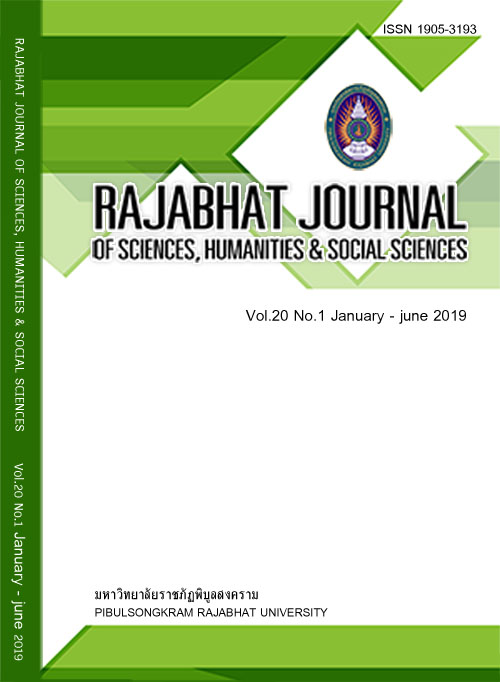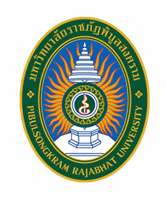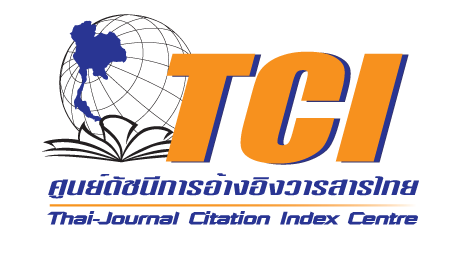การผลิตมีเทนโดยการย่อยร่วมของน้ำกากส่ากับกากน้ำตาล และการศึกษาปฏิกิริยาทางจลนพลศาสตร์
คำสำคัญ:
แก๊สชีวภาพ, น้ำกากส่า, ของเสียกระบวนการผลิตน้ำตาล พลังงานทดแทน, พลังงานทดแทนบทคัดย่อ
งานวิจัยนี้มีวัตถุประสงค์เพื่อเพิ่มประสิทธิภาพการผลิตมีเทนโดยใช้การย่อยร่วมแบบไร้อากาศระหว่างน้ำกากส่ากับกากน้ำตาลโดยกระบวนการหมักแบบกะ และศึกษาปฏิกิริยาทางจลนพลศาสตร์ของกระบวนการผลิตมีเทนที่สภาวะเหมาะสม เพื่อใช้ในการประเมินระยะเวลากักเก็บ (Hydraulic retention time) และอัตราภาระบรรทุกสารอินทรีย์ (Organic loading rate) สำหรับใช้ในกระบวนการหมักแบบต่อเนื่อง ผลการทดลองแสดงให้เห็นว่ากระบวนการย่อยร่วมระหว่างน้ำกากส่ากับกากน้ำตาลช่วยเพิ่มประสิทธิภาพการผลิตมีเทนและประสิทธิภาพการกำจัดค่าซีโอดี (Chemical oxygen demand: COD) ให้สูงขึ้นเมื่อเทียบกับการใช้น้ำกากส่าเป็นสับสเตรทเพียงชนิดเดียว โดยอัตราส่วนของน้ำกากส่าต่อกากน้ำตาล และความเข้มข้นของสับสเตรทที่เหมาะสมที่สุด คือ 3:2 และ 10 g-volatile solid (VS)/L ตามลำดับ ได้ปริมาตรแก๊สมีเทนสะสมและค่าผลได้ของมีเทนสูงที่สุดเท่ากับ 3,847 mL/L และ 385 mL/g-VS ตามลำดับ มีประสิทธิภาพในการกำจัดค่าซีโอดีสูงที่สุดเท่ากับ 91.59% จากการศึกษาปฏิกิริยาทางจลนพลศาสตร์ของกระบวนการผลิตมีเทนที่สภาวะเหมาะสม พบว่า ค่าคงที่ของอัตราการเกิดปฏิกิริยา (k) ที่ได้จากสมการปฏิกิริยาอันดับหนึ่งมีค่าเท่ากับ 0.135 d-1 โดยสามารถประเมินระยะเวลากักเก็บ และอัตราภาระบรรทุกสารอินทรีย์ได้เท่ากับ 30 d และ 0.34 g-VS/L.d ตามลำดับ
References
American Public Health Association. Standard Methods for the Examination of Water and Wastewater. 19th ed. Washington D.C.: American Public Health Association; 1995.
Angelidaki I, Ellegaard L. Codigestion of manure and organic wastes in centratlized biogas plants; status and future trends. Applied Biochemistry and Biotechnology. 2003; 109(1-3): 95-106.
Department of Alternative Energy Development and Efficiency. Current Ethanol Production Plant in Thailand, 2017. Available at: https://www.dede.go.th/ewt_dl_link.php?nid=329. Accessed January 8, 2018.
Esposito G, Frunzo L, Giordano A. et al. Anaerobic co-digestion of organic wastes, Reviews in Environmental Science and Biotechnology. 2012; 11: 325-341.
Fang C, Boe K, Angelidaki I. Anaerobic co-digestion of desugared molasses with cow manure; focusing on sodium and potassium inhibition, Bioresource Technology. 2011; 102: 1005-1011.
Fang HHP, Liu H. Effect of pH on hydrogen production from glucose by a mixed culture, Bioresource Technology. 2002; 82: 87-93.
Linke B. Kinetic study of thermophilic anaerobic digestion of solid wastes from potato processing, Biomass and Bioenergy. 2006; 30: 892-896.
Lutz H, Esuoso K, Kutubuddin M. et al. Low temperature conversion of sugar-cane by-products, Biomass and Bioenergy. 1998; 15(2): 155-162.
Mariano AP, Crivelaro SHR, Angelis DF, Bonotto DM. The use of vinasse as an amendment to ex-situ bioremediation of soil and groundwater contaminated with diesel oil, Brazilian Archives of Biology and Technology. 2009; 52(4): 1043-1055.
Moraes BS, Zaiat M, Bonomi A. Anaerobic digestion of vinasse from sugarcane ethanol production in Brazil: Challenges and perspectives. Renewable and Sustainable Energy Reviews. 2015; 44: 888-903.
Naspolini BF, Machado ACO, Cravo Junior WB, Freire DMG, Cammarota MC. Bioconversion of sugarcane vinasse into high-added value products and energy, BioMed Research International. 2017. DOI: https://doi.org/10.1155/2017/8986165.
Owen WF, Stuckey DC, Healy JB. et al. Bioassay for monitoring biochemical methane potential and anaerobic toxicity, Water Research. 1979; 13(6): 485-492.
Parnaudeau V, Condom N, Oliver R. et al. Vinasse organic matter quality and mineralization potential, as influenced by raw material, fermentation and concentration processes, Bioresource Technology, 2008; 99: 1553-1562.
Pattra S, Sangyoka S, Boonmee M. et al. Bio-hydrogen production from the fermentation of sugarcane bagasse hydrolysate by Clostridium butyricum, International Journal of Hydrogen Energy. 2008; 33: 5256-5265.
Vrieze JD, Plovie K, Verstraete W. et al. Co-digestion of molasses or kitchen waste with high-rate activated sludge results in a diverse microbial community with stable methane production. Journal of Environmental Management. 2015; 152: 75-82.
Ward AJ, Hobbs PJ, Holliman PJ. et al. Optimisation of the anaerobic digestion of agricultural resources, Bioresource Technology. 2008; 99: 7928-7940.
Wilkie AC, Riedesel KJ, Owens JM. Stillage characterization and anaerobic treatment of ethanol stillage from conventional and cellulosic feedstocks, Biomass and Bioenergy. 2000; 19: 63-102.
Xia Y, Cai L, Zhang T. et al. Effects of substrate loading and co-substrates on thermophilic anaerobic conversion of microcrystalline cellulose and microbial communities revealed using high-throughput sequencing, International Journal of Hydrogen Energy. 2012; 37: 13652-13659.
Xu R, Zhang K, Liu P. et al. A critical review on the interaction of substrate nutrient balance and microbial community structure and function in anaerobic co-digestion, Bioresource Technology. 2018; 247: 1119-1127.
Zheng XJ, Yu HQ. Inhibitory effects of butyrate on biological hydrogen production with mixed anaerobic cultures, Journal of Environmental Management. 2005; 74: 65-70.
Downloads
เผยแพร่แล้ว
How to Cite
ฉบับ
บท
License
Each article is copyrighted © by its author(s) and is published under license from the author(s).









